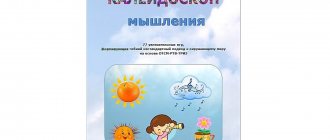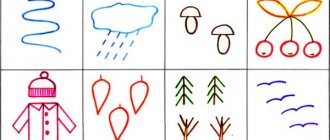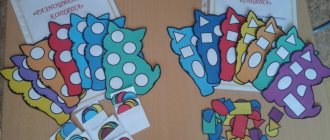Seminar - workshop for teachers of preschool educational institutions "TRIZ Technology"
In preschool childhood, children love to create something new and are very proud of it. However, observing children in a group, we often notice that not all works are distinguished by independence, originality and manifestation of creative abilities.
How to develop creativity in children, how to help a child, what conditions to create for his creative growth, so that the child does not get lost, but is happy when left alone with a difficult task.
(Slide) In this work, use the “Technology for solving inventive problems”, which was created by the scientist-inventor T.S. Altshuller.
The main goal that TRIZ teachers set for themselves is: - formation of creative thinking in children, i.e. education of a creative personality prepared for stable solution of non-standard problems in various fields of activity, namely, the development in students, on the one hand, of such qualities of thinking as flexibility, mobility, systematicity, dialecticism; on the other hand, search activity, the desire for novelty; speech and creative imagination. Thus, the TRIZ methodology can be called a school of creative personality, since its motto is creativity in everything: in posing a question, in methods of solving it, in presenting material.
(Slide) The main criterion in working with children when using TRIZ is clarity and simplicity in the presentation of material and in the formulation of a seemingly complex situation. You should not force the implementation of TRIZ without children understanding the basic principles using simple examples. Fairy tales, playful, everyday situations - this is the environment through which a child will learn to apply TRIZ solutions to the problems he faces.
Often, you, teachers, are already using this technology without even knowing it.
At the moment, the theory of solving inventive problems in preschool educational institutions has a large number of specific expressions. The following methods and techniques are characterized by the greatest popularity.
- (Slide) Brainstorming is the collective generation of ideas. Brainstorming works most effectively when children are immersed in a fictitious situation where some hero, necessarily positive, supposedly needs help, advice, salvation, recommendation, etc. (let's help Alyonushka/kitten, Dunno, Little Red Riding Hood/thoughtful Prince..." ).
The basic rules of the MS are:
- exclusion of serious criticism;
- encouragement of the most extraordinary and incredible proposals;
- the ability to modernize other people's ideas;
- the presence of joint discussions, through which the group selects the most optimal ones from all the answers and allows them to solve the problem with minimal losses.
To better consolidate the experience, the results obtained during brainstorming should be put into the form of practical activity and create some kind of product reminiscent of the game: a drawing, a craft, etc.
(Slide) Synectics method (advanced brainstorming)
The concept of “synectics” means “the unification of heterogeneous elements,” and the essence of the technique itself is the search for constant analogies.
The types of connections between objects can be different:
- Personal (empathic). Here the preschooler is usually asked to imagine himself in the image of some object or phenomenon within a problem situation. Sometimes the tasks turn out to be more specific and easy (“depict a cat who didn’t like the food she bought”), sometimes more abstract and complex (“depict Chungi-Changi’s reluctance to eat only coconuts and bananas”).
- Direct. The guys find such pairs from different fields of knowledge, which are based on the same patterns. For example, a submarine looks like a fish, a helicopter looks like a dragonfly, an airplane looks like a bird, helmets and helmets look like the shells of turtles, snails and other creatures.
- Fantastic. Here the teacher and his charges create their own rules and norms that ignore existing rationality. For example, children are asked to “think about what love/joy/happiness/excitement looks like” and draw it. As a result, the analogies that are embodied on paper will turn out to be completely different: someone will draw a plant, someone will draw a person, someone will draw an animal, etc.
(Slide) Catalog method
Goal: To develop skills of analysis and synthesis, creative imagination, fantasy.
Essence of the method:
Improving objects through assigning qualities to other objects. ( car - watch (properties) - round, running, shiny; galoshes - shiny, black, waterproof, comfortable)
Grouping items (selecting items for tea utensils - highlighting the unnecessary: pot, frying pan).
(Slide) Resource method
Goal : Development of imagination, modeling skills.
Essence of the method:
Replacing the harmful effects of the energy of “fields” with an object (subject).
Types of "fields"
Mechanical; Chemical;
Acoustic; Electrical;
Thermal; Magnetic.
For example : The teacher invites children to replace (introduce) the action of any “field” to prevent an unfavorable action and obtain a favorable result.
For example: Fairy tale “The Three Little Pigs”
1.Chemical field:
“Naf-Naf took pepper-scented deodorant and sprayed it around his house. The wolf approached the house and started sneezing.....”
2.Mechanical field:
“Nuf-Nuf dug a deep ditch around his house, and planted rose hips along the edge. The wolf came...”
3.Acoustic field:
“Nif-Nif placed sound sensors around his house. The wolf came, and the sensors sounded like a fire siren.....”
(Slide) Modeling with little people (MMH)
One of the most visual embodiments of TRIZ technology in action is the method of modeling with little people. Thanks to it, preschoolers learn to imagine what objects of living and inanimate nature look like from the inside, what processes take place in them, and what the substances that fill them are. Little people can appear in the form of drawings, toys, or children themselves. This method is used when the teacher needs to explain, for example, the process of melting an icicle: in winter the tiny inhabitants are cold, and they hold hands tightly, while with the establishment of spring warmth they begin to move, turning into water. (they no longer hold hands, but lightly touch each other). Upon transition to a gaseous state, MPs begin to move, scattering in different directions. This technology develops intelligence, attentiveness, observation, and also teaches modeling and schematization.
(Slide) Method “System analysis”
It helps to consider the world in a system as a set of elements interconnected in a certain way, conveniently functioning with each other. Its goal is to determine the role and place of the functions of objects and their interaction for each sub-system and supra-system element.
For example: System “Little Frog”, Subsystem (part of the system) - paws, eyes, circulatory system, Supersystem (a more complex system that includes the system in question) - pond. The teacher asks questions: “What would happen if all the frogs disappeared?”, “What are they for?”, “What benefits do they bring?” (Children offer options for their answers and judgments). As a result, they come to the conclusion that everything in the world is organized systematically and if one link of this chain is broken, then another link (another system) will certainly be broken.
(Slide) Method of contradictions. Perception of the same object (action, phenomenon...) as opposite assessments (good - bad; dangerous - not dangerous..)
Any object (action, phenomenon...) is selected and positive and, at the same time, negative aspects are identified. For example, a book - what is good and what is bad.
(Slide) Method of fantasy: do the opposite, increase - decrease, dynamics - statics, etc. The “increase” technique. Waking up one morning, the residents of our city saw that the grass in the city had “grown to the fifth floor.” What will happen next? Who will like it and who won't? What problems will city residents face? What will be the consequences?
(Slide) Collage of fairy tales (inventing new fairy tales based on fairy tales already known to children, familiar characters in new circumstances, a fairy tale from a rhyme, rescue situations in fairy tales, fairy tales from “living” drops and blots).
Here we have looked at several TRIZ methods.
Dear Colleagues! Now I invite you to take part in a creative game, where you can show miracles of resourcefulness, ingenuity, and innovative thinking, based on consolidating the theoretical knowledge of TRIZ.
- Tasks to test the inertia of thinking. It is required to quickly answer the questions of the tasks. You can think about it, but not for long. 1. How many fingers are there on 2 hands and on 4?
- He sits in the swamp and speaks French. Who is this? (explain since when did frogs start speaking, and in French too).
- Solve a problem situation: (brainstorming)
“The grasshopper was jumping and jumping and injured his leg. How can I help him?
— How can a zoo director accurately and quickly measure a poisonous snake?
- Making wishes ( Fantasizing method)
- If I were a bird, I would...
- If I were a musical instrument, I would...
- What will happen? ( Fantasy method)
— What would happen if animals spoke with human voices?
— What will happen if the mountains turn into sugar mountains?
- What will happen if... ( Fantasy method)
— Will a person's life ever end?
— Does every person wear everything they own?
- Empathy method:
You can use words, pantomime, facial expressions.
— How does a flower feel when it is watered by rain?
— What if people walked through a clearing where a flower grows?
- Help Cinderella (brainstorming or rescue situations in fairy tales)
Cinderella kneaded the dough. When I had to roll it out, I discovered that there was no rolling pin. And the stepmother ordered to bake pies for dinner. How does Cinderella roll out the dough? Children's answers: we need to go to the neighbors and ask them; go to the store, buy a new one; maybe an empty bottle; or find a round log, wash it and roll it out; cut the dough into small pieces, and then press it with something heavy.
- Scientists have developed a new breed of hare. Outwardly, he is, in general, the same as ordinary hares, but only the new hare is black. What problem will the new hare have? How to help a new hare survive? Children's answers: (It is easier for a fox to hunt a black hare... He is especially clearly visible in the snow... Now he only needs to live underground... Or where there is no snow at all, but only black earth... And he can go for a walk now he only needs to at night... He needs to live with people so that they take care of him, protect him...)
- Rescue situations in fairy tales.
“One day the kitten decided to swim. He swam very far from the shore. Suddenly a storm began and he began to drown. . .” Offer your options for saving the kitten.
- (System analysis)
- In this task you are given a system. It is necessary to select as many words as possible included in this system. The first team was the LES system, the second team was the RIVER. (Forest - hunter, wolf, trees, bushes, path; River - bank, fish, fisherman, water, mud).
- Write an advertisement for a newspaper so that the words begin with the same letter. Example: for sale is a singing fluffy parrot, Painka, five years old, half-green. Prefers to eat cookies and drink Pepsi-Cola. Please come take a look.
Thus, today we are convinced that the use of TRIZ methods and techniques in work allows us to remove psychological barriers, eliminate the fear of the new, the unknown, and form the perception of life and educational problems not as insurmountable obstacles, but as regular tasks that need to be solved.
Thank you for your attention and participation!



